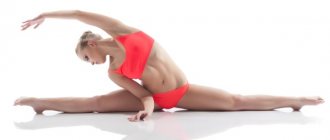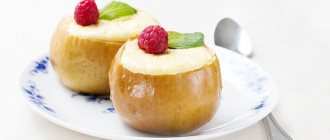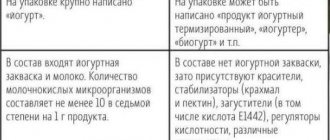What is twine
A split is a gymnastic figure in which the legs are spread in two directions and pressed to the floor. There is a cross split - the most difficult option, which requires careful preparation from a person: stretching the leg muscles and tendons, as well as good mobility of the sacrum and hip joints. When performing it, the legs are positioned along one line, for this reason this exercise is often called the “rope”. Longitudinal, unlike transverse, is a simpler option. When performing it, one leg should be directed forward and the other back. Even people with not very good stretching by nature can master the technique of longitudinal splits.
It is worth noting that this pose has a beneficial effect on the body, as a result of which: • the thigh muscles, as well as the buttocks and abdomen, are strengthened; • the volume of fat deposits decreases; • mobility of the sacrum and hip joints improves; • intestinal function is stimulated and blood circulation in the abdominal area becomes better.
Doing the splits is of great importance for women's health. Firstly, this pose serves as a good prevention of varicose veins and diseases of the genitourinary system. Secondly, it allows you to normalize the menstrual cycle and will not only be a good preparation for childbirth, but will also facilitate the course of pregnancy itself.
How to dye polyester rope?
Polyester thread, or monofilament, unlike natural fibers, is difficult to dye. It is easier to buy ready-made polypropylene rope in the desired color. If this is not possible, then try one of the methods suggested below.
- in green: dilute 10 ml of brilliant green in a glass of water and keep the thread in this solution for about 1 minute;
- in yellow or brown: immerse the thread for a few seconds in a 5% iodine solution, the intensity of the shade depends on the exposure time.
Stages of dyeing 450 g of polyester thread:
- wash and rinse the thread thoroughly;
- in an enamel saucepan, bring 7.5 liters of water to a boil;
- dissolve 5 to 15 g of coloring powder in a small amount of liquid, strain, pour into water;
- add a teaspoon of laundry detergent to the mixture;
- immerse the skein in the solution and boil for 30 to 40 minutes;
- rinse in water;
- wash with a small amount of washing powder to remove excess dye.
I hope that the material presented is enough to properly dye any type of cord or rope on your own. The following video will help you understand the above.
The desired result is obtained after the second stage of whitening. And if some areas just don’t want to become light, you can drop the gel on these places and they will begin to discolor before your eyes.
Powder bleach "Boss"
The second product I use is Boss bleach. Thanks to it, the threads become simply snow-white.
It contains active oxygen, which fulfills its main mission.
This product has only one small drawback: it is advisable to use the entire package at once.
After opening, the active substance is quickly destroyed and the whitening properties of the product are reduced.
If you decide to use the powder after opening it after about 2 weeks, the result will be 2 times worse.
Correct split
It is unlikely that any person doing exercises to prepare for the splits thinks about the correctness of its execution. Of course, the correct longitudinal split is not so difficult to perform due to its characteristics, but the biomechanics of the transverse split are more complex, so the technique of its correct execution is necessary for everyone who trains in this skill. Numerous sites will help you figure out what the correct split looks like, offering not only the help of pictures and photographs to verify the correctness of your execution, but also offering schemes for performing this exercise.
Bleaching jute twine
I believe that before you start dyeing, you first need to decide on the palette in which you will dye the jute. This is necessary so that the finished result is as close as possible to the desired one.
If your palette has light colors and shades and you want to get the most “pure” color possible, then the twine must be bleached before dyeing.
Important! For bleaching and dyeing, do not wind the twine into skeins that are too large.
It's better to have several small ones than one big one. In this case, it will be easier for you to work with winding and the coloring (bleaching) result will be uniform.
Bleaching jute rope using regular bleach
I soak the threads in a strong bleach solution and leave them in a closed container for several hours (usually overnight).
It’s rare that you can immediately bring a whole skein to the desired color. Therefore, this process can occur in several stages until the pure white color of the threads is obtained.
It depends on the thickness of the twine and the quality of the bleach . The latter is especially important.
I have tried whiteness from different manufacturers and different price categories.
The quality of bleach depends on the active chlorine content in it. After all, it is the chlorine molecules that are responsible for the bleaching process itself.
Here you will have to experiment and empirically determine which bleach is better. I chose “Whiteness-gel” for myself. It is more expensive than regular “Whiteness”, but it is much more economical in operation.
The desired result is obtained after the second stage of whitening. And if some areas just don’t want to become light, you can drop the gel on these places and they will begin to discolor before your eyes.
Powder bleach "Boss"
The second product I use is Boss bleach. Thanks to it, the threads become simply snow-white.
It contains active oxygen, which fulfills its main mission.
This product has only one small drawback: it is advisable to use the entire package at once.
After opening, the active substance is quickly destroyed and the whitening properties of the product are reduced.
If you decide to use the powder after opening it after about 2 weeks, the result will be 2 times worse.
What does a correct cross split look like?
The generally accepted opinion is that the transverse is a more complex version of the twine, but this is not entirely true. Doing both types involves some difficulties. In addition, for many people the complexity of the transverse or longitudinal splits seems different - some are better at one, others at the other.
The simplest version of the longitudinal split seems to be when the knees and toes are turned up, and the legs themselves are on the same line. In addition, it is important that the back remains straight and does not bend forward or backward; the buttocks must be tucked, as well as the stomach.
Dyeing jute twine
Now you can start dyeing and you will find out how you can dye thread for crafts.
As I said earlier, I like natural shades: such as mahogany, polysander, lemon, etc. To achieve this palette, I used alcohol wood stain.
Wood stain
What can I say about the stain? She dyes jute beautifully!
The color is natural, rich and the colored twine has a pleasant shine. The color of the thread is even and dyed evenly along the entire length.
Another positive aspect of this method is that it is very economical. At a low cost, one bottle is enough to dye a large amount of twine.
Another big plus for me is that the dyed thread does not stain your hands when working. Agree, it’s not very pleasant to work with green or black hands.
But this method also has disadvantages.
Firstly, it's the smell. The chemical-alcohol-acetone smell will permeate your room for a long time. Therefore, it is worth taking care of good ventilation.
Dyed threads will also have this specific smell, and I don’t know how long it will take for it to completely disappear. After 2 weeks the smell was still there. To be honest, my finished work also had the same aroma, but much weaker than in a skein of thread. And after covering the work with varnish, you had to smell it to feel it. Something like that. Draw your own conclusions.
Secondly, this is the “dirtiest” staining method. Use thick rubber gloves when working. Polyethylene ones, which are used for hair coloring, will not work.
Pour stain into an unnecessary container (I had a glass jar) and lower a skein of thread into it so that the liquid completely covers the skein. Leave for a couple of minutes. Then take it out, wring it out and rinse under running water. While I was washing off the remaining paint, my entire bathtub was stained. Then I had to clean it all up at once.
If you have a bathtub with chipped enamel, then be careful, the stain will stain everything and it will be difficult, maybe even impossible, to clean it. I dried the dyed skeins by laying them out on regular newspaper.
Hair dye
I found another palette of natural shades... in hair dyes.
This is where coloring became not a challenge, but a pleasure!
The paint is diluted according to the attached instructions. Since jute is very hygroscopic, it can be diluted with a small amount of water.
We wait for the time according to the instructions (you can even do it longer, this is not hair) and rinse well with running water. The smell after the procedure remains pleasant and disappears quite quickly, and the thread does not stain your hands while working, which is very pleasing.
But the result of staining may not be unambiguous.
If you take a skein that is too large, there may not be enough paint and, not only will the finished color be unsaturated and dull, but the thread will not be dyed evenly. Therefore, you should take small skeins so that there is enough paint for the entire length of the skein.
Squeeze the jute well in the paint so that it can penetrate deep into the thickness of the thread. In this case, you will get the most desired result. After you have dyed one skein, you can add another one to the remaining paint.
The color saturation of the second skein will be less than the first, the third even less. Here is the result of dyeing three skeins of jute with black hair dye.
You can experiment for a very long time.
The first disadvantage of this method is its high cost. The prices of paints are very expensive, and you can only paint a small amount of thread.
The second drawback is that without UV protection, the color fades over time. Therefore, the work must be varnished with a UV filter.
Iranian henna
I found a relative alternative to this method in the same department where I bought the paint.
Iranian henna can also provide its own palette of natural shades. Coloring and its process are described in the instructions, so I will not repeat it.
The color saturation depends on how much henna you take. Experiment, the results will be very interesting.
The smell of henna quickly disappears, and your hands do not turn red during the process. And the paint itself is not very expensive.
The disadvantage of this method is the monotonous palette.
I tried to diversify it with the help of basma, but to be honest, it turned out to be nonsense. Either the basma I got was not of good quality, or the stars in the sky didn’t align well, but the result did not impress me with either the color or the uniformity of coloring. In the future I will try to carry out this experiment again, if I get something interesting, I will definitely tell you about it.
Food colorings
Well, in conclusion, I want to share my striking results.
No matter how much I like natural shades, my working palette should also include joyful sunny colors. They are perfect for making flowers!
I dyed the pre-bleached twine with regular natural food dyes.
She dissolved the dyes in water with the addition of table vinegar and bathed the skeins in multi-colored solutions. Coloring took me an hour. Then I rinsed some of the skeins under running water.
But when they dried, I saw that the thread was not dyed evenly.
The remaining skeins were simply wrung out and dried. But I didn’t see any difference between the first result and the second. The threads were still dyed unevenly in some places. Maybe I did something wrong. Don't know.
I would like to note a very big advantage of this coloring method - when mixing colored solutions in different proportions, you can get the most incredible range of colors. Products in these colors will definitely be unique. And of course, it makes your hands very pleasant after work - they remain quite clean, and not bright orange or blue.
I think you can still indulge in greenery)))
Acrylic paints
I started trying this method quite recently. But I don't dye the thread initially before work. Therefore, it would probably not be correct to talk about this method as a coloring method.
I paint the finished work with acrylic paints.
And I must say that I liked this idea.
- The paint goes on smoothly and as needed.
- You can achieve any shades that are needed for a specific job.
- You can paint the entire product or just a part.
- During the process, everything remains clean except the brush and palette.
See photos for examples of work. Read about the experiment with tinting in this article.
What does a correct longitudinal twine look like?
The correct longitudinal twine is more difficult to describe, however, when performing it, you should, first of all, focus on the following technology:
- pay attention to the position of the knee of the back leg, it should be directed clearly towards the floor, while the heel tends to rise;
- the front and back legs should be mentally positioned on the same straight line, it happens that the back leg moves diagonally, so it is necessary to monitor the position of the body during the splits;
- One of the common mistakes is that the knees of both legs are not fully straightened, or the thigh is not stretched and not lowered enough - good stretching, which is usually performed before the splits, can help correct these mistakes.
Why can't I do the splits?
This often happens - a person trains for a long time, but still cannot do the splits. In order to understand what prevents you from taking this acrobatic pose, you should take into account that one set of stretching exercises is not enough. Firstly, first of all, you should have a clear idea of the diseases that a person has suffered or that he has in a chronic condition. In addition, you will need to arm yourself with some knowledge about the human nervous system, its muscular and musculoskeletal system.
Secondly, you need to take into account the individual physiology of a person in order to understand where in the body there is a problem that does not allow you to fully assume the desired position. There are situations when injuries that occurred in the past affect the stretching and elasticity of muscles so much that a person can train as much as he wants, but still cannot do the splits.
What is flexibility, elasticity and stretching
When preparing for the splits, knowledge of some terminology is required, which allows you to create more effective sets of exercises, taking into account an individual approach. We are talking about such, at first glance, similar terms as “flexibility”, “elasticity” and “stretching”. Flexibility is the ability of an individual to do certain exercises with a large amplitude. Flexibility is also referred to as a certain range of joint motion that occurs in an instant.
Elasticity is characterized as the property of the tissues of the human body, after they have been subjected to strong force, to return to their original shape. Typically, elasticity refers to human muscles and tendons.
Stretching refers to a system of physical exercises aimed at specific muscles and tendons in order to stretch them, tone them and increase their elasticity.
What does flexibility depend on?
Our flexibility depends primarily on elasticity. Our joints will be able to gain much greater amplitude during movement if the muscles and tendons are more elastic. And, conversely, with poor elasticity of muscles and joints, flexibility is significantly reduced.
In order to perform the splits, you should train certain muscle groups: adductor major, brevis and longus;- pectineus muscle;
- thin muscle;
- muscles of the back of the thigh.
- Most people who are confident in their flexibility still cannot do the splits. The answer to the question “why?” follows from the biomechanics of this pose. The fact is that our body’s ability to be in such a state manifests itself in such a way that contraction must occur in certain muscles. It is this contraction that depends on the elasticity of the muscles, but what is also important in this process is the length of the ligaments and the structure of the joints. To see if you can perform this acrobatic pose, you can do a simple test at home. To do this, you just need to approach the table and, standing sideways to it, try to throw either of your legs on the table, while it is important to understand that the height of the table should not be higher than your hip. If you can perform this exercise with ease, this means that the ligaments and muscles are in excellent condition, and mastering the splits will not be difficult. In the event that you were unable to complete this exercise, but still do not intend to give up your goal, it is better to devote some time to stretching - training focused on those muscle groups that are active in a given position.
Jute ropes blog
After reading this article, you will learn how you can modify a standard jute thread. This is its original golden color that everyone is used to.
And such a jute thread is obtained after bleaching.
Therefore, bleaching can and should be done!
Below is a description of how to do this:
After bleaching, the jute thread becomes slightly thicker. The structure of the thread unravels because it remains in water for a long time. But with further use this does not in any way affect its strength and quality. Therefore, bleached jute thread can be used in knitting in contrasting shades.
Jute can be dyed before bleaching if you need dark colors for decorative purposes. In this case, you can paint it chocolate or black. They can be obtained without prior bleaching.
Whitening
To obtain bleached thread, you need to use the most common and cheapest Whiteness.
How to use it? Add 250 ml of white to 1 liter of water. Pour this solution into a bucket, stir well and immerse the jute in it.
Attention!
We only work with gloves so as not to burn our hands. Whiteness is chemistry. It corrodes everything. Next, what to do with the thread? We wind the thread through the elbow and hand. Do such manipulations 20 times. Figuratively speaking, we are making a winding skein. Then tie it loosely with a rope on both sides so that there is no lump. Otherwise, in this place the thread will remain unbleached. Place the winding in a bucket. During the bleaching process, the threads must be completely immersed in the solution. Leave for 8-10 hours. The water becomes yellow and the thread becomes light. After the specified time has passed, drain the solution and rinse the jute well. Then, dry.
How much thread should I wind?
It is necessary to make on average 20 skeins per 1 liter. If you make a solution of 2 liters of water and 500 ml of bleach, you can bleach 40 skeins in order to prepare more.
Bleached jute thread is quite light compared to the original natural color, but it will never be snow-white.
You can make the bleach solution more concentrated, but this is a chemical that corrodes the fibers. As a result, the thread will be loose and unsuitable for use.
For what purpose is jute thread bleached?
Nothing is knitted from one bleached thread. It takes a long time to bleach a large amount of yarn, so it is used only for decoration. You can dye natural jute - jute ropes, ropes, fabric - in dark colors, as mentioned above, or use bleached jute for painting in other brighter colors.
Coloring
For this purpose, acrylic paint or tinting acrylic paste is used.
We paint with gloves on a plastic bag with a paint brush. It is important to know! If the piece of thread is small, it is necessary to tie knots at the ends so that the thread does not unravel during the dyeing process.
Add paint to a small amount of water depending on the desired shade (darker or lighter). The color must be brought to a liquid colored state. Paint with the consistency of stain, so that it is water, it flows and saturates all the fibers. If you paint it with thick paint, the jute will be very hard, almost like oak.
Next, wet the brush and paint over a piece of thread. If you need a brighter color, then you need to add more paint to the water.
Conclusion
As you can see, coloring is possible. As a result, the jute turns out (unlike the original natural) to be an absolutely stunning alternative color.
What does the central nervous system have to do with splits?
Those who have deeply studied the theory of muscle stretching and preparing the body for the splits are very perplexed by the question of how this pose and the human nervous system are connected.
The fact is that the nervous system perceives the splits as one of the most dangerous positions of the body, therefore, when performing it, it will work as hard as possible, trying to protect the body from injury, accordingly, no matter how hard you try, the body will go against any attempt to move into this position. There is only one way out of this situation - to follow the main principle of stretching - gradual action.
You need to remember - no matter how long it takes you to take the required position (for each person this is a different time interval), it is important to slowly “accustom” the nervous system to the fact that there is no danger in this position.
How to choose the right twine
The Russian market offers a large assortment of twines and threads made from polypropylene of various manufactures. How to choose the best option in terms of price and quality? How to determine the quality of purchased twine? This article will answer these questions. When choosing twine, you should pay attention to the following:
- First of all, you need to find out by what standards the twine you want to purchase is created. The Russian market offers twine made according to Russian standards GOST and TU, as well as foreign twine made according to ISO standards, TU BY. Why is this necessary? These standards specify the main characteristics of twine and the conditions under which it can be used. As an example, from TU BY 400031289.078-2013 for twine produced in Belarus, we can find out that the breaking load of polymer twine TEKS 2200 with index C (for use in agriculture) is 81 kNs. This figure is lower than GOST 17308-88, according to the standard of which our products are manufactured. Although this GOST is outdated, the technical characteristics of hay twine manufactured according to this standard are confidently superior to some foreign analogues. Based on the conditions of GOST 17308-88, technical twine TEKS 2200 (hay tying) must have a minimum breaking load of 98 kgf, which is a fairly serious indicator. Not all manufacturers are able to produce hay tying twine with such strength; in this case, they resort to various tricks, which will be discussed in other paragraphs.
- What is the linear density of the twine? It is worth paying attention to the permissible deviation of the linear density of the twine, which should be at the level of ±10%. It follows from this that, in fact, the linear density of the manufactured thread can be in the range from 1980 to 2420 TEKS. That is why many enterprises try to set themselves a high bar (2400 TEKS) in order to increase the margin of safety and be within the “GOST” standards for breaking load. For the consumer, this can result in 10% damage, since in fact the linear density is 1000 meters more, and the footage itself is 10% less.
- There are twine manufacturers who produce their products according to specifications, which indicate a density deviation within ±20%. Such indicators may indicate the use of recycled materials in the production of twine, which in turn will negatively affect the quality of the produced twine. In order not to get caught in manipulations with the linear density of manufacturers when choosing twine, it is recommended to obtain a sample of twine from two different 10-meter reels and weigh each sample on a kitchen scale in increments of 0.1 g. To make it easier to determine TEX using scales, we have compiled a table of TEX correspondence to the weight of 10 meters of twine:
| TEX | Weight of a 10-meter segment in grams |
| 800 | 8 |
| 1000 | 10 |
| 1200 | 12 |
| 1600 | 16 |
| 2200 | 22 |
| 5000 | 50 |
| 7000 | 70 |
Such a check can protect you from unnecessary costs.
- Another important nuance that needs to be taken into account when choosing is the number of twists per meter. The twine should be round and well twisted. In this case, the thread has higher strength and is able to withstand shock loads. This happens precisely due to twists, which affect the elasticity of the thread and ensure that shock vibrations are distributed evenly.
- Next, it is worth studying the fibrillation of twine or thread. Fibrillation is the longitudinal splitting of a thread to improve strength and elasticity. With a higher quality of execution and a large number of cuts, the twine will be softer. The fibrillated thread is stronger than its poorly fibrillated counterpart. You can check this simply by unrolling the twine thread and assessing its structure; the thread should be mesh without large gaps in the cells.
- The quality of the winding can also indicate the quality of the thread itself. If it is even and the distance between the turns is minimal, using such a skein will be comfortable. For example, in the last meters you can avoid the outer turns “collapsing” inside the coil.
- Despite the fact that GOST does not standardize the softness of twine, it is still worth paying attention to it. Softness is the result of its fibrillation. As practice shows, soft twine is much more convenient to use, holds knots tighter and has a slight abrasive effect.
- An important indicator is the number of threads. All products manufactured by our company are single thread, but for TEX at the 7000-9900 level it is allowed to use several threads. If the twine consists of one thread like ours, then when the thread unravels it does not fall apart, and the structure remains strong and does not turn into fringe. If the twine consists of many threads, the rupture of only some of them leads to the fact that damaged threads begin to accumulate in narrow places and lead to rupture.
- Impurities in twine. Chalk concentrate is the main additive in twine. In addition, a wide range of dyes and light stabilizers is used to stabilize the thread. The addition of chalk concentrate can be assessed by the structure of the twine - it is drier and has a lighter shade. And the thread itself has a natural translucent color. Previously, chalk was used only as an additive to improve the extrusion process. Currently, manufacturers use large amounts of chalk concentrate to reduce the cost of twine. This technique is also used when it is necessary to paint over low-quality recycled products. Chalk is an abrasive material, which leads to a rapid increase in wear of rubbing parts. As for dyes, in this case everything is quite simple. Good dyes differ from cheap ones in their rich shade. At the same time, bright additives negatively affect the breaking load of the thread. Thus, dye-free polypropylene twine will be stronger than its dyed counterpart. When making twine, a light stabilizer is often added, which is necessary to ensure that the twine is resistant to direct sunlight. As a consequence, the higher the part of the stabilizer, the better the protection. 1.5% additive should guarantee protection of twine strength for one year. The presence of such an additive is checked either by the manufacturer or in the laboratory. If you need a large batch of twine, it is more profitable to order from the manufacturer of the products you need. It is also recommended to inquire about the customers to whom such twine is supplied and the percentage of additives contained. If production refuses to provide such information, this may raise doubts about the quality of the twine. A small cost benefit can turn into a disaster on the farm. Well, if you are very interested in the price of twine, but don’t have time to check, then it is recommended to buy colored twine or thread. This is due to the fact that the dye can serve as a kind of stabilizer additive.
The article discussed the main nuances that must be taken into account when choosing polypropylene twine. Aware means armed. In any case, our specialists are ready to advise you on the selection of twine that will meet your requirements and wishes.
Sincerely, employees of the sales department of the Polymer-Service company.











